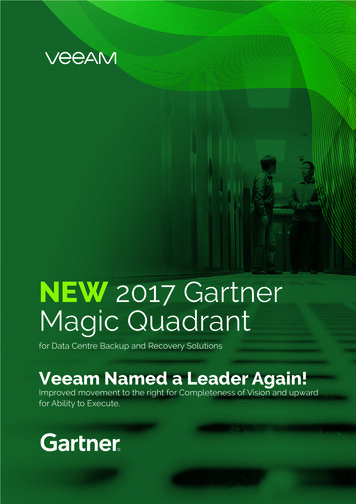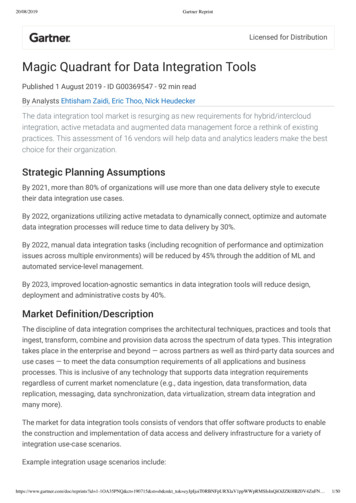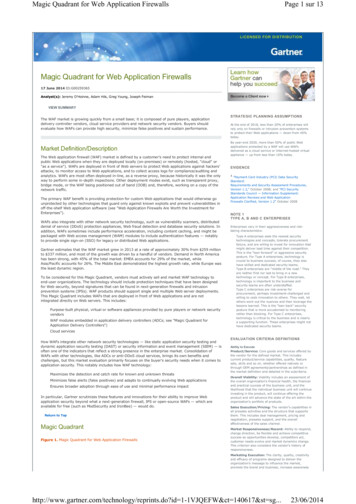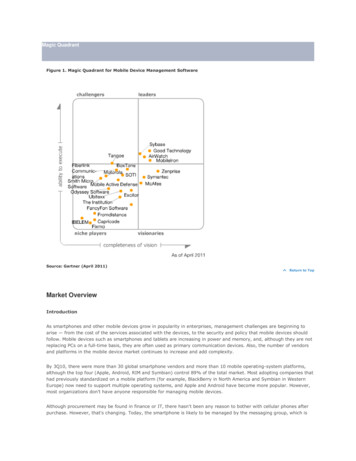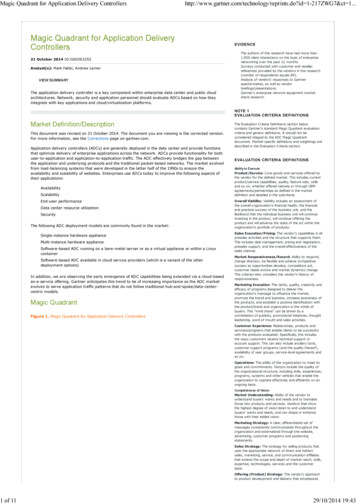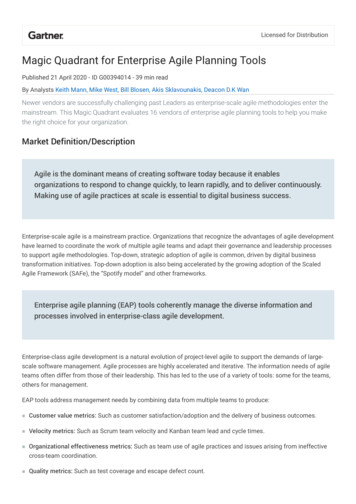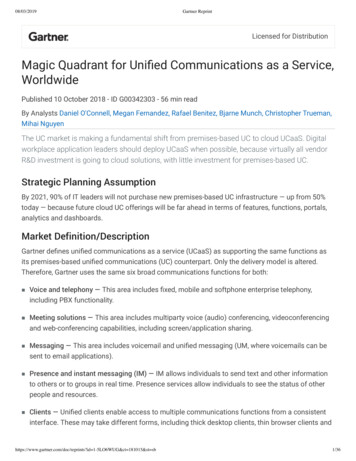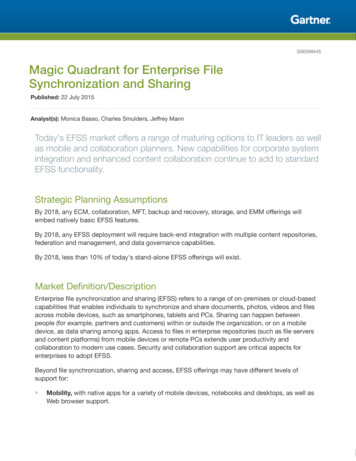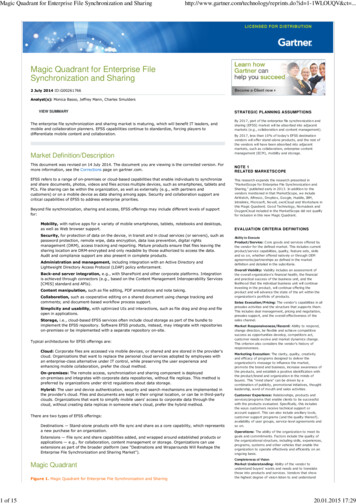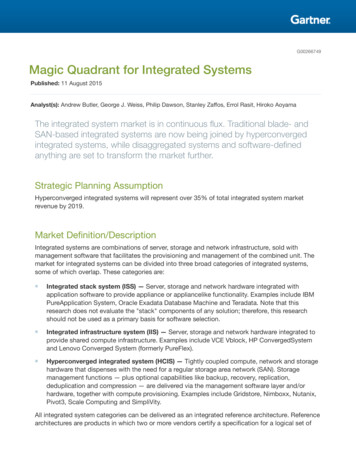
Transcription
G00266749Magic Quadrant for Integrated SystemsPublished: 11 August 2015Analyst(s): Andrew Butler, George J. Weiss, Philip Dawson, Stanley Zaffos, Errol Rasit, Hiroko AoyamaThe integrated system market is in continuous flux. Traditional blade- andSAN-based integrated systems are now being joined by hyperconvergedintegrated systems, while disaggregated systems and software-definedanything are set to transform the market further.Strategic Planning AssumptionHyperconverged integrated systems will represent over 35% of total integrated system marketrevenue by 2019.Market Definition/DescriptionIntegrated systems are combinations of server, storage and network infrastructure, sold withmanagement software that facilitates the provisioning and management of the combined unit. Themarket for integrated systems can be divided into three broad categories of integrated systems,some of which overlap. These categories are: Integrated stack system (ISS) — Server, storage and network hardware integrated withapplication software to provide appliance or appliancelike functionality. Examples include IBMPureApplication System, Oracle Exadata Database Machine and Teradata. Note that thisresearch does not evaluate the "stack" components of any solution; therefore, this researchshould not be used as a primary basis for software selection. Integrated infrastructure system (IIS) — Server, storage and network hardware integrated toprovide shared compute infrastructure. Examples include VCE Vblock, HP ConvergedSystemand Lenovo Converged System (formerly PureFlex). Hyperconverged integrated system (HCIS) — Tightly coupled compute, network and storagehardware that dispenses with the need for a regular storage area network (SAN). Storagemanagement functions — plus optional capabilities like backup, recovery, replication,deduplication and compression — are delivered via the management software layer and/orhardware, together with compute provisioning. Examples include Gridstore, Nimboxx, Nutanix,Pivot3, Scale Computing and SimpliVity.All integrated system categories can be delivered as an integrated reference architecture. Referencearchitectures are products in which two or more vendors certify a specification for a logical set of
hardware and/or software components and, ideally, offer a common source of service and support.Reference architectures can form any one of the categories listed above, and valid integratedsystems can target specific reference architecture opportunities.As an additional type of reference architecture, hyperconvergence vendors may engage with one ormore hardware vendors to create a solution based on their own software stack supported by thirdparty hardware. Examples include Cisco working with Maxta, Atlantis Computing and SimpliVity,and Dell working with Nutanix. Some hyperconvergence vendors only deliver reference architecturesthrough their software value-add (a "bring your own hardware" approach to complement theirsoftware solutions). We exclude such approaches from this research.Some forms of reference architectures, such as EMC VSPEX, allow vendors to group separateserver, storage and network elements from a menu of eligible options to create an integrated systemexperience. This reference architecture type may be based on a loose partnership betweenhardware and software vendors, or between multiple hardware vendors. Support and escalationmay also be divided across multiple vendors. Reference architectures that only support a variety ofhardware and software components are more variable by their nature and, therefore, more difficultto assess versus packaged integrated systems. Deploying these reference architectures without asingle point of support may also result in a variable support experience that makes it difficult toassess them versus packaged integrated systems. Because of these factors, we have chosen not toevaluate this reference architecture type in this research. However, where eligible vendors alsoengage in initiatives to create a reference architecture from a prescriptive blueprint, we do assessthis reference architecture type as part of our overall evaluation of the vendor.Adding further market complexity, potential buyers frequently evaluate different categories ofintegrated systems against one another. For instance, because IIS solutions are generic,multipurpose systems that can run a variety of workloads, it is common for one IIS offering to becompared with another. But buyers who want to deploy a specific workload might compare an ISSsolution, like Oracle Exadata Database Machine or IBM PureApplication System (both of which havethe workload embedded), with a generic IIS that is also capable of running the workload, or with anIIS platform that has an applicable reference architecture.That being said, it would be rare to see one ISS competing with another ISS, because the choice ofstacks and workload takes priority over the choice of platform. So, if Oracle Database ManagementSystem (DBMS) serving deployment is the required workload, the preferred ISS solution wouldobviously favor an Oracle Engineered System. However, client inquiries indicate that HCIS solutionsare increasingly challenging IIS competition, especially where concerns about technology lock-inare high.It is also increasingly common for HCIS solutions to be evaluated as a form of IIS solution,especially in greenfield situations where no integrated system has been bought before. HCISvendors will challenge the need for, and expense of, SAN technology and enterprise blade servers— both of which are usually associated with IIS solutions.It is because these different types of systems are evaluated against each other that this MagicQuadrant assesses different classes of integrated system. It assesses the vendors in terms ofhardware (server, network and storage), operating system and virtualization software alongside anyPage 2 of 36Gartner, Inc. G00266749
associated management tools and high availability (HA) solutions. It considers hardware depth andscale, software stack management breadth and depth, and support of the infrastructure, as well asflexibility in the use of reference architectures. This research is not intended to judge embeddedsoftware stacks, application or platform components individually, such as middleware, DBMSsoftware and cluster software in the application or DBMS tiers.The TechnologyMost IIS and ISS solutions are based on blade server technology, with closely coupled SAN ornetwork-attached storage (NAS), which enable boot-from-disk capability for all physical and virtualnodes; thus, making the system stateless. Blades are not a prerequisite, however, and somevendors will promote rack-based solutions as well.HCIS solutions, in contrast, are usually based on rack-optimized nodes, which can be extended innumber through the life of the system. The majority of IIS and ISS solutions are really effectivepackaging of server, storage and networking components that are sold as separate products in theirown right, while HCIS solutions are purpose-designed and -built to form part of an integratedsystem. While the individual building blocks of both HCIS solutions and IIS/ISS solutions may be assmall as a single-socket rack-optimized node or blade server, it is common for IIS/ISS solutions toscale to dozens — even hundreds — of nodes. HCIS solutions offer broad scaling in theory, but areusually limited to smaller configurations. HCIS scaling is also influenced by the probability that somenodes will be deployed for more storage rather than extra compute capacity. Most HCIS vendorspromote the software differentiation of their solution, and prefer to stress that the hardware is highlycommoditized. But we are also seeing the emergence of new-generation chassis-based fabricbased computers (FBCs) that merge the three compute, storage and network elements moreseamlessly. These solutions will place more emphasis on hardware differentiation.Overall, the great majority of integrated systems are based on Intel or AMD x86 technology, butthere is some support for reduced instruction set computer (RISC) variants like Power and SPARC,and the emerging market for ARM and Intel Atom processors will have applicability for someintegrated system use cases.Gartner, Inc. G00266749Page 3 of 36
Magic QuadrantFigure 1. Magic Quadrant for Integrated SystemsSource: Gartner (August 2015)Vendor Strengths and CautionsCiscoLast year, this Magic Quadrant assessed Cisco on its collaboration with NetApp and EMC, whichboth remain active today. But Cisco's partnering strategy has expanded since then to include manyPage 4 of 36Gartner, Inc. G00266749
more choices for integrated systems. Today, Cisco's Unified Computing System (UCS) integratedinfrastructure portfolio includes an expanded combination of storage reference architectures,including Hitachi, IBM and Nimble Storage. These all build on the NetApp FlexPod referencearchitecture paradigm. Cisco continues its partnership with VCE, but at a lowered investment givenit was acquired by EMC. In addition to providing vertically scaling integrated systems such as itdoes with VCE and the storage vendors listed above, Cisco has a presence in the market for HCISthrough technology partnerships with SimpliVity, StorMagic, ScaleIO, Maxta, and VMware VirtualSAN hosted on rack-optimized Cisco UCS. These partnerships enable Cisco to deliver a singlescale-out HCIS solution hosted on rack-optimized UCS systems. Cisco has evolved a managementstrategy, UCS Director, to enable the hoster's central systems to manage distributed remote sitesand edge systems, or to create clustered solutions for applications based on big data analytics,such as Hadoop.Cisco's highly visible success as a partner in the VCE coalition, together with its NetApp referencearchitectures, has enabled the company to establish credibility as a compute vendor in large global500 enterprises and to become a leader in the blade server market. But with market interest in HCIScontinuing to grow, Cisco has yet to demonstrate that it can extend its success to modular, scaleout systems that integrate UCS and direct-attached storage from center to edge, and deliver asoftware-defined storage (SDS) offering that can compete with many recent entrants in the HCISmarket. Moreover, as Cisco continues to expand partnerships beyond VCE that may compete moredirectly against non-Cisco compute nodes of EMC (made up of VxRacks and VSPEX Blue), usersshould validate Cisco's ability to deliver a single integrated service and support experience acrossan array of configurations while maintaining an ever-expanding compatibility and validation matrixamong partners and component suppliers.Strengths Cisco has a strong Vblock data center presence with repeat buys. Cisco offers multiple storage reference architectures, including a market-leading NetAppsolution that uses FlexPod, while expanding its portfolio of solutions through partnerships withSimpliVity, StorMagic, Maxta and other HCIS technologies. Cisco has a large global sales channel and support team with strong complementaryengineering capabilities.Cautions Cisco's lack of native storage solutions creates barriers to further IIS/HCIS progress for thecompany, as this emphasizes the reliance on external partners. Cisco's HCIS strategy is still in a nascent phase, and builds mainly on partnerships such asthose with SimpliVity, Maxta and StorMagic. Cisco faces further competitive dilution as EMC-VCE broadens its focus to offer low-costcompute, scale-out storage and expanded management capabilities.Gartner, Inc. G00266749Page 5 of 36
DellDell offers a broad portfolio of integrated systems that span the whole integrated system market.Platforms like PowerEdge VRTX and Microsoft Cloud Platform System (CPS) are highlydifferentiated versus the competition. VRTX offers a low-end, integrated system aimed at small ormidsize business (SMB), midmarket, branch and departmental needs. VRTX is designed to bedeployed and easily managed in a regular office without the need for dedicated IT infrastructure.CPS, a tailored Azure platform for cloud projects, is a joint development between Dell and Microsoftwherein hardware support is unique to Dell. However, Dell's broadest market opportunity comesfrom the PowerEdge FX2 platform, which launched in 2014. Dell sells FX2 both as a new generationblade server and as an integrated system. Dell is also a certified hardware node vendor forVMware's Evo:Rail and a certified SAP Hana appliance vendor.Dell has many software assets that facilitate integrated system deployment, including closeintegration between the Active System Manager management suite and Dell's own cloudmanagement platform, Dell Cloud Manager. In addition, Dell has a strong relationship with Nutanix,with the Nutanix software suite being certified as the Dell XC integrated appliance.Dell is a globally recognized data center brand that is executing its separate server, networking andstorage strategies well, and existing users of Dell servers and other technology should consider thecompany for relevant integrated system projects. However, Dell pursues a "pull" marketingapproach that reacts to customer demand, but has struggled to create broad awareness andrecognition in this market, where Dell has not established itself yet as a leading vendor. Sales haveconsequently been sluggish across the portfolio.Strengths Dell sells a strong portfolio of integrated systems that spans all the categories that Gartner hasdefined, and is aided by strong partnerships with vendors like Nutanix and Microsoft. Some Dell solutions, such as VRTX and CPS, are highly differentiated in the market. Dell has overcome the uncertainties over going private and is executing its server and storagestrategies well, giving the company a good global foundation for integrated system marketgrowth.Cautions Dell's integrated system positioning has been inconsistent. Multiple branding initiatives and avariety of software acquisitions have muddled the end-user perception of Dell as an integratedsystem vendor. FX2 has the capacity to be a unifying force for Dell's strategy, but a muted product launchrobbed Dell of the opportunity to make a stronger initial impression with what is a highlyinnovative product. Although successful in their respective markets, platforms like VRTX and CPS address a veryfinite audience, with limited opportunity for sales success to benefit Dell's broader integratedsystem market opportunity.Page 6 of 36Gartner, Inc. G00266749
EMC (VCE)In December of 2014, EMC acquired 90% ownership of VCE. Cisco owns 10% with long-termagreements with VCE regarding engineering, customer support and resellers. VCE is now a memberof the EMC Federation. As a result of the ownership change we no longer assess VCEindependently of EMC, and this year's reference to the vendor as EMC (VCE) reflects the transitionin progress. With its majority ownership of VCE, EMC has become a formidable source of integratedsystems, providing combined EMC-VCE engineering designs. EMC has kept VCE's organizationintact including engineering, sales, support and marketing, with close collaboration among VCE andother members of the EMC Federation. VCE continues to run its factory integration (in the dedicatedVCE assembly facility), testing and support.Most recently, VCE announced its rack-scale hyperconverged VxRack. The first VxRack is expectedto ship in 3Q15 using Britebox servers, Cisco top of rack (ToR) switches and EMC ScaleIOsoftware-defined storage. Later this year, a second VxRack personality will ship encompassingVMware's Evo:Rack.VCE announced VxBlocks that offer the choice of Cisco Application-Centric Infrastructure (ACI) andVMware's NSX software-defined networking solutions. VxBlocks, Vblocks and VxRacks will scaleup and scale out using a new architecture called Vscale. VCE also enables technology extensionssuch as EMC Isilon storage and Cisco UCS servers to attach to Vblocks. VCE's Vision software willexpand its provisioning, compatibility and life cycle management across multiple systems withconnected blocks and racks. The combination of EMC and VCE represents EMC's other integratedsystem interests, such as VSPEX Blue (which is an EMC-branded HCIS implementation of Evo:Railwith additional EMC-sourced capabilities that enable data protection, backup and recovery in anappliance platform). Users will need to hold discussions potentially with multiple arms of EMC andits VSPEX suppliers to ascertain specific roadmap, direction and overall integration strategies.Strengths EMC is able to build on VCE's established position as one of the clear leaders in the integratedsystem market with Vblocks. EMC offers factory-integrated and -validated reference architectures for enterprise missioncritical applications. EMC is a proven global vendor with extensive channel and direct sales, plus service, support.Cautions EMC's VSPEX Blue hyperconverged solutions have relatively high average entry upfront costsand long configuration to deployment cycles versus competing HCIS solutions. EMC-VCE has not been in the market long enough to establish a reputation in HCIS and increating scale-out capability on Vblock fabric.Gartner, Inc. G00266749Page 7 of 36
EMC may struggle with how to position its various platforms based on use cases, applicationsand scale, including recognition that new SAN-less racks and VSPEX appliances pose potentialcannibalization of SAN-based block solutions.FujitsuFujitsu has been investing in an integrated system portfolio for longer than most vendors, withinitiatives like FlexFrame (built on a collaboration with SAP and NetApp) and Processing AreaNetwork (PAN) Manager (an alliance with Egenera) dating back more than a decade. As Fujitsu hasexpanded its portfolio to include more reference architectures and ready-to-run systems, itsprevious lack of a consistent brand has created growing confusion over its company strategy andcommitment. In 2014, Fujitsu simplified its integrated system brand under the name Primeflex. Thecompany has now implemented the branding across all regions, including Japan (where separatebranding has previously been the norm for many years).Today, Fujitsu sells multiple offerings that target a range of workloads and use cases — primarilyPrimeflex for SAP Landscapes (with scope for OpenStack support), Primeflex for SAP Hana (whichcan be integrated with Primeflex for SAP Landscapes), Primeflex for HPC, Primeflex Cluster-in-abox, Primeflex for VMware VDI, Primeflex for VMware Evo:Rail, Primeflex for Cloud, Primeflex forHadoop, Primeflex for HA Database and Primeflex for Analytics. Fujitsu also offers numerousreference architectures as Primeflex solutions that target workloads like virtual desktopinfrastructure (VDI), VMware VSAN (software-defined storage), Microsoft Exchange and MicrosoftLync. These solutions are driven both by direct and indirect channels.The breadth of the Fujitsu portfolio is impressive, but creates an added responsibility for Fujitsu todemonstrate how it can position its products to address multiple target segments more effectivelythan the competition. Without clear positioning, it becomes a challenge for Fujitsu to demonstrateits strengths and points of differentiation in an increasingly crowded and confused market.Strengths Fujitsu has created a broad combination of integrated systems, appliances and referencearchitectures, which are well-supported by Fujitsu's own technology and by that from partnerssuch as SAP. The company also offers an end-to-end service portfolio and good independentsoftware vendor (ISV) partnering. Fujitsu is steadily extending its global sales reach beyond its stronger regions of Japan andWestern Europe, but it is still able to focus regionally where required. For instance, Primeflex forVMware Evo:Rail has achieved most traction with U.S. and Western European audiences, whilePrimeflex for HPC has been shipp
integration between the Active System Manager management suite and Dell's own cloud management platform, Dell Cloud Manager. In addition, Dell has a strong relationship with Nutanix, with the Nutanix software suite being certified as the Dell XC integrated appliance. Dell is a globally recogn

